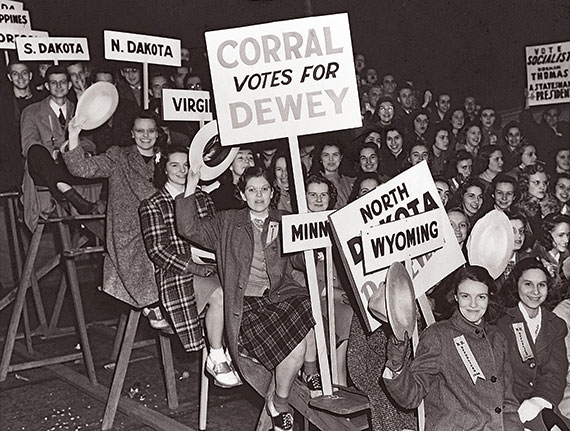Then: Political Theater
Tell us what you think. E-mail comments or questions to the editors at letters@northwestern.edu.
Find Us on Social Media

Delegates show their support for Republican presidential candidate Thomas Dewey at the 1940 Mock Political Convention on Roycemore Field (now Long Field).
Northwestern was in full presidential campaign mode in April 1936 when Lloyd McDonald ’36 climbed into the sky aboard a rented plane and dropped Democratic leaflets on the Evanston campus and his Republican-leaning peers. It was one of the more memorable stunts surrounding the Mock Political Convention, a quadrennial Northwestern tradition from 1908 to 1968.
Held every four years in late April, the MPC featured torchlight parades, fiery campaign speeches — by the likes of Sen. Joseph McCarthy — heated debates and occasional hijinks as student delegates nominated candidates for president and vice president and voted on a slate of issues, including support for women’s suffrage and condemnation of the Ku Klux Klan. One of the oldest continuous college political conventions, the MPC was an open forum for students to express their opinions on the critical issues facing the world.
The convention might have been a window into the world of young Americans, but it was not a good predictor of electoral success. The MPC nominee won the White House just three times — Calvin Coolidge in 1924 and Dwight Eisenhower in 1952 and 1956.
The nominees sometimes lacked serious political promise. Entertainer Will Rogers lost in the balloting for vice president by just four votes in 1932. And the 1952 ballot included New York Giants manager Leo Durocher, the only candidate who would “play ball with the senators,” according to one delegate.
The convention drew more than 3,000 people to McGaw Memorial Hall in 1956, making it the largest such event in the nation. But by the late ’60s the students were losing interest. When the voting age was changed to 18 in March 1971, students were eager to participate in the real political arena.



 Facebook
Facebook Twitter
Twitter Email
Email


